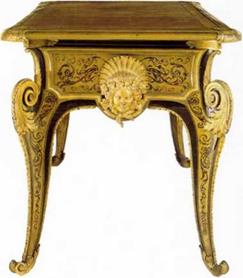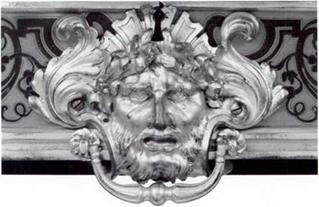A survey of Boulle’s output reveals not only its creative force but also its homogeneity. Its principal characteristic is the importance of sculptural elements: gilt-bronze mounts play a completely new role in the history of furniture. On earlier pieces by Gole. Cucci and Oppenordt. the mounts remain subordinate to the architectural elements of the cabinets, which were really temples or triumphal arches in miniature, whereas Boulle gives the mounts a much larger scale and uses them in profusion. They become central elements in the composition, the panels of marquetry organized around them. On earlier furniture, marquetry scrolls were delineated within compartments. In Boulle’s case the marquetry swags and tendrils seem to extend the design of the gilt-bronze mounts. Conversely, an arabesque in marquetry can be extended by a small gilt-bronze trophy which seems to be suspended. The least important of his bronze mounts are still of very high quality. They were original creations, modelled by the greatest sculpteurs of the time who were often Boulle’s neighbours in the Galeries du Louvre, or colleagues working with him on the same commissions from the Batiments du Roi. As well as Desjardins, with whom Boulle was employed in 1699 at Meudon on the bronzes for the Dauphin’s chimneypiece (‘with putti. mosaics and trophies’), or Girardon and Coustou whose names were found in the 1732 inventory, mention must be made of Jean Varin. Daniel Bouthemy, Van Opstal. Louis Lecomte and Francois Flamand. whose models in terracotta or wax were in Boulle’s possession at the time of the fire in 1720. Finally, the third of Boulle’s sons. Andre-Charles II. was a talented sculptor who was awarded the second prix de Rome in 1709.
The 1732 inventory, published by M. Samoyault. gives a list of Boulle’s bronzes, which is indispensable to a study of Boulle’s work. The repertoire of bronzes was largely inspired by classical mythology (Saturn, the Fates. Atlas. Mars. Ceres. Pomona. Bacchus) and in particular the Metamorphoses of Ovid (Apollo and Daphne. Apollo and Marsyas). Themes from contemporary sculpture were readily adopted (the Four Seasons. the Stoic and Epicurean Philosophy with the masks of Heraclitus (48] and Democritus). Certain bas-reliefs copied contemporary paintings such as Aspasia and the Philosopher. The treatment of animals was very naturalistic (lions’ masks and paws of various types, rams’ heads and hooves). Certain motifs on pedestals or g^ridons were inspired by those from the upholstery style fashionable during Louis XIV’s reign, such as the gilt-bronze fringes which imitate the ‘campanes’ or festooned tablecloths. The motifs of putti. a decorative element much favoured by the King in about 1700. appeared frequently: putti in flight holding up drapery (31]. reclining putti (60]. Eolus or Zephyrs with bulging cheeks
(38). Motifs borrowed from antique statuary often reappear, such as escutcheons in the form of peltas found on numerous bureaux. A screaming mask, perhaps representing Hercules, also sometimes called ‘Bellone’, appears on the cornices of armoires. sometimes alternating with calm masks (53]. The most frequent ornamental motifs are male or female fauns’ heads, their hair plaited or wreathed in fruiting vines. Boulle used a number of grimacing or smiling masks which must not be confused with the masks of Apollo and Daphne with braids tied beneath the chin. The motifs of female heads found on the corner mounts of furniture, which at first glance seem similar, are in fact of four types. The earliest type, as seen on the Wil – denstein [55] and Dashwood tables, reappears in a more vigorous manner on the commodes at Trianon [17]. The same bust, but without wings, is found on the bureaux plats [35]. The last type, wearing a Chinese hat [33]. seems to anticipate the work of Cressent.

 |
 |
To appreciate fully Boulle’s originality in his own time would require a precise chronology of his work. But the problem is that very little of his work can be dated before 1701. and most of the furniture which is illustrated in Mariette’s folio of engraved plates must be dated after 1707. An exact date for these prints is in fact difficult to establish. Mariette included them in the second edition of L’Architecture a la mode which did not appear until after 1707 (the date of the death
of Marictte’s nephew. Nicolas II Langlois, who published the first edition in 1705). Mariette included in this second edition plates by Pineau (1684-1754) and Gilles-Marie Oppenord (1672-1742. son of the ebeniste Alexandre-Jean). which, together with those by Boullc. represented the new style which would come to be known as Regence. For these reasons the plates might be dated around 1715-20.



